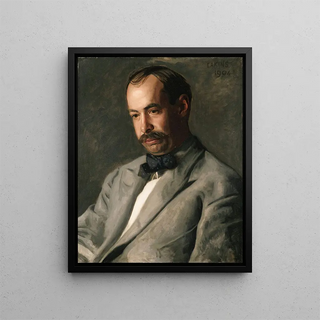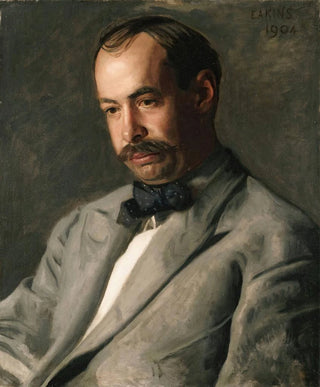Art print | Charles Percival Buck - Thomas Eakins


View from behind

Frame (optional)
In the world of art, some works transcend the simple frame to become windows into bygone eras. The art print Charles Percival Buck - Thomas Eakins is one of those creations that invites the viewer to delve into the fascinating universe of late 19th-century America. Through this piece, Buck does not merely reproduce Eakins's portrait but captures the very essence of the man and the artist, offering a glimpse into his creative genius. This portrait represents not just an individual, but also evokes a reflection on the role of art in society at the time, encouraging a deeper contemplation of the cultural and aesthetic issues of the era.
Style and uniqueness of the work
Buck's art print stands out for its meticulous attention to detail and its ability to convey a unique atmosphere. Buck's style, imbued with a certain delicacy, harmonizes beautifully with Eakins's dynamic personality. The nuances of color, the texture of the clothing, and the expression on the face are all elements that help bring the portrait to life. Buck uses light in a masterful way, creating shadows that add depth and volume, making the character almost tangible. This work of art print goes beyond simple imitation; it is an interpretation that reveals the complexity of the depicted artist. Indeed, Eakins, known for his realistic approach and his passion for representing the human figure, finds here an echo in the penetrating gaze and confident posture emanating from the painting.
The artist and his influence
Thomas Eakins, an emblematic figure of American art, marked his era with his commitment to realism and his exploration of themes related to the human condition. His influence extends far beyond his own work, touching generations of artists who sought to capture the truth of life through their art. Eakins always advocated the importance of direct observation and anatomical study, an approach that revolutionized the way the human figure was depicted in art. Through his portraits, he was able to immortalize not only faces but also stories, emotions

Matte finish

View from behind

Frame (optional)
In the world of art, some works transcend the simple frame to become windows into bygone eras. The art print Charles Percival Buck - Thomas Eakins is one of those creations that invites the viewer to delve into the fascinating universe of late 19th-century America. Through this piece, Buck does not merely reproduce Eakins's portrait but captures the very essence of the man and the artist, offering a glimpse into his creative genius. This portrait represents not just an individual, but also evokes a reflection on the role of art in society at the time, encouraging a deeper contemplation of the cultural and aesthetic issues of the era.
Style and uniqueness of the work
Buck's art print stands out for its meticulous attention to detail and its ability to convey a unique atmosphere. Buck's style, imbued with a certain delicacy, harmonizes beautifully with Eakins's dynamic personality. The nuances of color, the texture of the clothing, and the expression on the face are all elements that help bring the portrait to life. Buck uses light in a masterful way, creating shadows that add depth and volume, making the character almost tangible. This work of art print goes beyond simple imitation; it is an interpretation that reveals the complexity of the depicted artist. Indeed, Eakins, known for his realistic approach and his passion for representing the human figure, finds here an echo in the penetrating gaze and confident posture emanating from the painting.
The artist and his influence
Thomas Eakins, an emblematic figure of American art, marked his era with his commitment to realism and his exploration of themes related to the human condition. His influence extends far beyond his own work, touching generations of artists who sought to capture the truth of life through their art. Eakins always advocated the importance of direct observation and anatomical study, an approach that revolutionized the way the human figure was depicted in art. Through his portraits, he was able to immortalize not only faces but also stories, emotions






